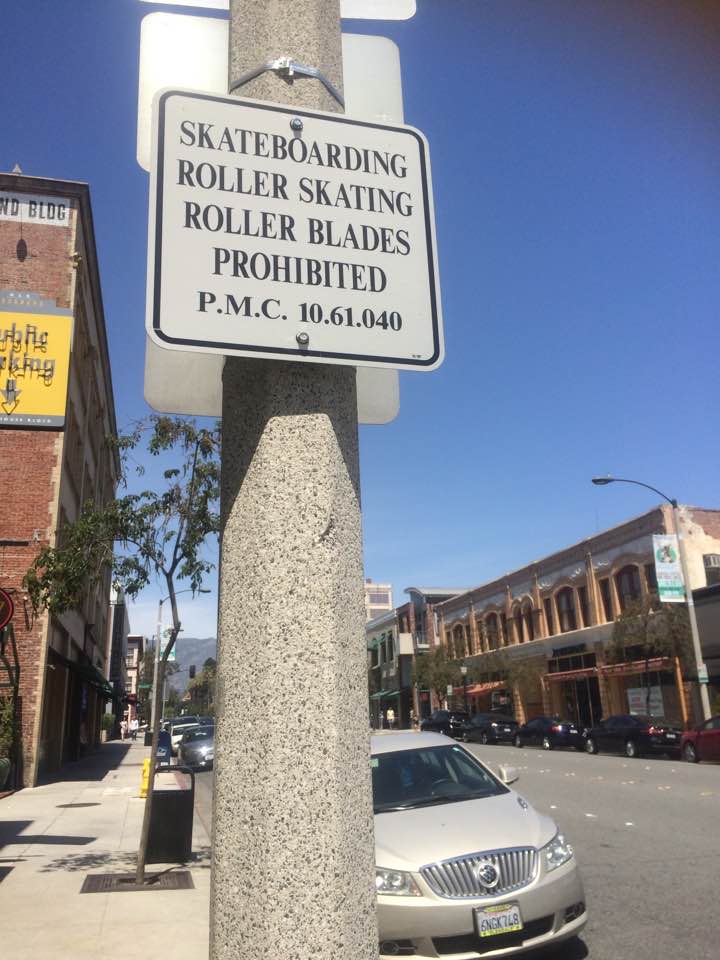This guest blog post was written by Dr. Mojgan (Mo) Sami, UC Irvine, Program in Public Health
As an active transportation planner and researcher, I am guilty of having focused on promoting bikeable and walkable infrastructure and policies without due consideration to the diversity of people-powered mobility on our streets and roads. It was not until a young skateboarder from Santa Ana approached me and asked, “Why don’t you plan for skateboarders?” that I began to think about the many invisible rollers on the streets who do not have their needs met in our current active transportation planning paradigm. Indeed, as the young skateboarder mentioned, “Not all pedestrians walk!” And, not all wheels are bikes!

This tweet from the Safe Routes Partnership’s #MoveEquity tweetchat highlighted the problems that arise from failing to consider the needs of wheelchair users and other human-powered transportation.
Traditionally, active transportation efforts have focused on improving walking and biking through programs such as Safe Routes to School and funding programs aimed at improving street infrastructure to make walking and biking safer. Walking and biking assessments are used by city staff, community organizations, and residents as advocacy tools to improve the conditions of their streets to promote active transportation. While all these efforts are contributing to health-promoting infrastructure, the near-exclusive focus on walking and biking has resulted in a gap in active transportation assessments, funding, and data that may lead to inequitable outcomes for skateboarders, wheelchair users, and other non-walkers and non-bikers on the road.

So, how do we plan for all rollers? The first step is to make the invisible rollers more visible in our planning, policies, and data sources. We can start by recognizing skateboarders, wheelchair users, and other human-powered transportation users as unique road users with their own unique safety needs, rather than lumping them all into the general “pedestrian” category, as many active transportation plans do.
CalTrans’ newly released draft Bike and Pedestrian Plan -- a statewide policy guide for all jurisdictions aiming to promote active or “people-powered” transportation in their communities – is one example of an active transportation plan that falls short. The CalTrans’ plan strives to ensure that Californians of all ages and abilities “can safely, conveniently, and comfortably walk or bicycle for their transportation needs,” but fails to meet the needs of non-bikers and non-walkers by effectively hiding them in the pedestrian category of road users.
The draft plan states: “A pedestrian is any person walking, skateboarding, using a wheelchair or other mobility device, or any other form of human-powered transportation other than a bicycle.” In addition, the plan uses “walking” to define any mode of travel on sidewalks. It states that “All pedestrians and bicyclists are included in active transportation.”
However, urban planners, law enforcement, and evaluators rarely (if ever) design tools or collect disaggregated data on the diversity of “pedestrians” and “walkers” on the street or sidewalk in any systematic matter. The lack of data detail on pedestrian/walkers is creating a gap in research and assessment for non-walkers and non-bikers in active transportation. This lack of attention to the different types of pedestrians on the sidewalk and the street could lead to inaccurate injury statistics, especially when it comes to people using skateboards or wheelchairs.
For instance, last month’s release of a report on national pedestrian fatalities by the Governors’ Highway Safety Association shows that pedestrian fatalities are up by 11 percent in 2016 as compared to 2015. Researchers point to high speed, distracted driving, and even the decreasing capacity for compassion and empathy as possible causes of pedestrian fatalities. However, as an active transportation and equity researcher, I want to know how many of these “pedestrian” fatalities were non-walkers? Is there a way to disaggregate injury/fatality statistics to get a better understanding of all “pedestrians?” If not, why not?
We also need to stop filtering our transportation infrastructure through a zero-sum game between cars and “alternatives.” Biking, walking, public transportation, skateboarding, wheelchairs, and other people-powered mobile devices are part of the ways that we get from place A to place B. In this effort, we have to assess all the different types of ordinances and policies that limit mobility choices and privilege the automobile – such as local policies that prohibit skateboarding. By disaggregating the data hidden in our current statistical methods of transportation, we can open up conversations and spaces for policy and infrastructure change that promote equitable mobility on our streets.

Photo by Dr. Mo Sami, taken in Pasadena, 2017
My informal conversations with planners, traffic engineers, and law enforcement officers showed an initial reluctance to disaggregate different types of pedestrians because the change seems overwhelming and cumbersome. However, business-as-usual strategies are not conducive to building an equitable policy framework and infrastructure that provide an opportunity for all rollers. It’s time to integrate assessment tools to ensure that all pedestrian categories are counted and assessed equitably. It’s time to have a broader conversation with bikers, walkers, wheelchairs, skateboarders, and other non-motorized people-powered rollers to create more opportunities for promoting active transportation in our communities.

It’s time to focus on equity for all users in active transportation by making the invisible communities of active transportation more prevalent in policy, planning, and data sources.
